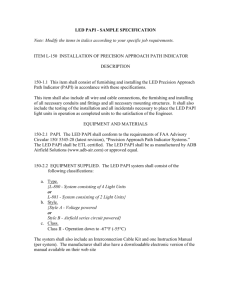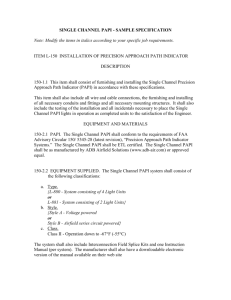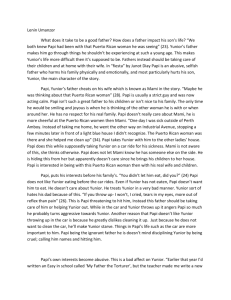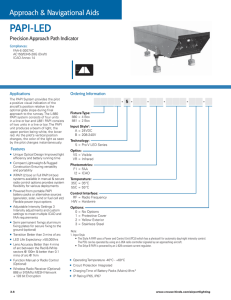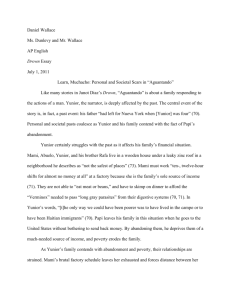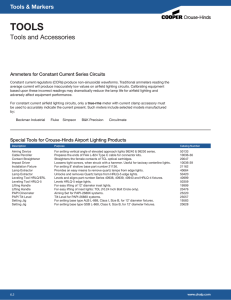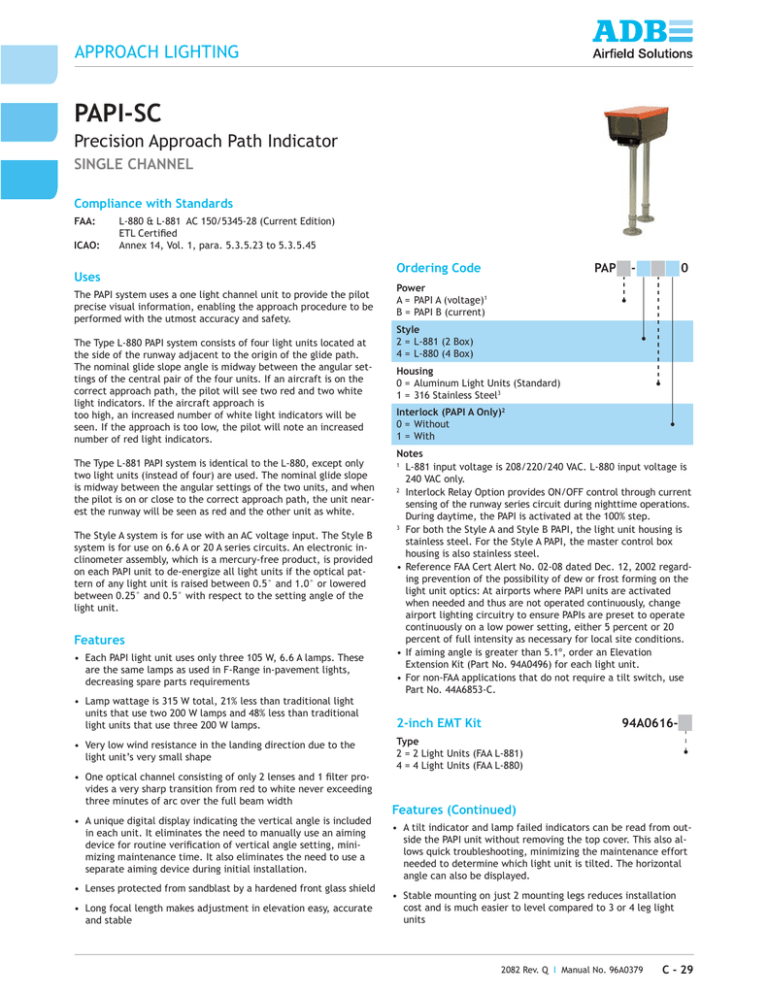
APPROACH LIGHTING
PAPI-SC
Precision Approach Path Indicator
SINGLE CHANNEL
Compliance with Standards
FAA:
ICAO:
L-880 & L-881 AC 150/5345-28 (Current Edition)
ETL Certified
Annex 14, Vol. 1, para. 5.3.5.23 to 5.3.5.45
Uses
The PAPI system uses a one light channel unit to provide the pilot
precise visual information, enabling the approach procedure to be
performed with the utmost accuracy and safety.
The Type L-880 PAPI system consists of four light units located at
the side of the runway adjacent to the origin of the glide path.
The nominal glide slope angle is midway between the angular settings of the central pair of the four units. If an aircraft is on the
correct approach path, the pilot will see two red and two white
light indicators. If the aircraft approach is
too high, an increased number of white light indicators will be
seen. If the approach is too low, the pilot will note an increased
number of red light indicators.
The Type L-881 PAPI system is identical to the L-880, except only
two light units (instead of four) are used. The nominal glide slope
is midway between the angular settings of the two units, and when
the pilot is on or close to the correct approach path, the unit nearest the runway will be seen as red and the other unit as white.
The Style A system is for use with an AC voltage input. The Style B
system is for use on 6.6 A or 20 A series circuits. An electronic inclinometer assembly, which is a mercury-free product, is provided
on each PAPI unit to de-energize all light units if the optical pattern of any light unit is raised between 0.5° and 1.0° or lowered
between 0.25° and 0.5° with respect to the setting angle of the
light unit.
Features
• Each PAPI light unit uses only three 105 W, 6.6 A lamps. These
are the same lamps as used in F-Range in-pavement lights,
decreasing spare parts requirements
• Lamp wattage is 315 W total, 21% less than traditional light
units that use two 200 W lamps and 48% less than traditional
light units that use three 200 W lamps.
• Very low wind resistance in the landing direction due to the
light unit’s very small shape
• One optical channel consisting of only 2 lenses and 1 filter provides a very sharp transition from red to white never exceeding
three minutes of arc over the full beam width
• A unique digital display indicating the vertical angle is included
in each unit. It eliminates the need to manually use an aiming
device for routine verification of vertical angle setting, minimizing maintenance time. It also eliminates the need to use a
separate aiming device during initial installation.
• Lenses protected from sandblast by a hardened front glass shield
• Long focal length makes adjustment in elevation easy, accurate
and stable
Ordering Code
PAP
-
0
Power
A = PAPI A (voltage)1
B = PAPI B (current)
Style
2 = L-881 (2 Box)
4 = L-880 (4 Box)
Housing
0 = Aluminum Light Units (Standard)
1 = 316 Stainless Steel3
Interlock (PAPI A Only)2
0 = Without
1 = With
Notes
1
L-881 input voltage is 208/220/240 VAC. L-880 input voltage is
240 VAC only.
2
Interlock Relay Option provides ON/OFF control through current
sensing of the runway series circuit during nighttime operations.
During daytime, the PAPI is activated at the 100% step.
3
For both the Style A and Style B PAPI, the light unit housing is
stainless steel. For the Style A PAPI, the master control box
housing is also stainless steel.
• Reference FAA Cert Alert No. 02-08 dated Dec. 12, 2002 regarding prevention of the possibility of dew or frost forming on the
light unit optics: At airports where PAPI units are activated
when needed and thus are not operated continuously, change
airport lighting circuitry to ensure PAPIs are preset to operate
continuously on a low power setting, either 5 percent or 20
percent of full intensity as necessary for local site conditions.
• If aiming angle is greater than 5.1º, order an Elevation
Extension Kit (Part No. 94A0496) for each light unit.
• For non-FAA applications that do not require a tilt switch, use
Part No. 44A6853-C.
2-inch EMT Kit
94A0616-
Type
2 = 2 Light Units (FAA L-881)
4 = 4 Light Units (FAA L-880)
Features (Continued)
• A tilt indicator and lamp failed indicators can be read from outside the PAPI unit without removing the top cover. This also allows quick troubleshooting, minimizing the maintenance effort
needed to determine which light unit is tilted. The horizontal
angle can also be displayed.
• Stable mounting on just 2 mounting legs reduces installation
cost and is much easier to level compared to 3 or 4 leg light
units
2082 Rev. Q I Manual No. 96A0379
C - 29
APPROACH LIGHTING
PAPI-SC I Precision Approach Path Indicator
Features (Continued)
Single Channel PAPI Baffle
• Reduced maintenance. The unit is fully sealed and remains
clean inside. Lamp, front glass, and red filter replacement does
not require any tools.
Light Box
2 = Two box Single Channel PAPI
4 = Four box Single Channel PAPI
• Colorimetric conformity maintained over the whole width of
the red beam
Cut-off Angle (Primary)
1 = 0 to 3.3 degrees
2 = 3.1 to 6.4 degrees
3 = 6.3 to 10 degrees
• No water can accumulate on the cover, so reflections that could
constitute a false optical signal are eliminated
• Use of only aluminum, stainless steel hardware and optical
glass provide a high degree of corrosion resistance. For extreme
environmental conditions, an optional stainless steel housing is
available.
• For Style A systems, a photoelectric control on the Master control cabinet automatically provides full intensity during the day
and a reduced intensity (5% or 20% of full intensity) at night.
Both the full and reduced intensity light level can be field adjusted. A circuit breaker is provided to permit the input power
to be de-energized for field maintenance.
• Only one PAPI light unit assembly is used on either a Style A or
Style B system, minimizing spare part requirements
94A0570-
Cut-off Angle (Secondary)
1 = 0 to 3.3 degrees
2 = 3.1 to 6.4 degrees
3 = 6.3 to 10 degrees
Note
The SC PAPI Baffle allows airports to modify the horizontal light
beam coverage of the PAPI unit for obstacle avoidance in the
approach area. See Service Bulletin ALN152 for field installation
details.
Exploded View
• Fixture uses a black light box with an international orange
cover and stainless steel hardware.
• Meets both Class I and II temperature ranges:
- Class I: -31 °F to +131 °F (-35 °C to +55 °C)
- Class II: -67 °F to +131 °F (-55 °C to +55 °C)
Adjustment of the beam elevation
The beam setting is quickly achieved in a most user friendly way
by means of an internal controller board, allowing for very precise
and stable elevation adjustment. No separate aiming device is
needed.
Electrical Supply
Each Type A PAPI system is powered from a Master Control box.
Each Type B PAPI light unit is powered with 6.6 A maximum via a
6.6A/6.6 A or 20 A/6.6 A 300 W isolation transformer. A field splice
kit is supplied with each light unit to provide for external electrical connections between PAPI system components.
Style A1
Input Voltage: 240 VAC, ±10%, 50/60 Hz
L-880 (4-box) 3-lamps/light unit
1,700 VA max.3
Input Voltage: 208/220/240 VAC, ±10%, 50/60 Hz
L-881 (2-box) 3-lamps/light unit
1,612 VA max.4
Style B
2
Three Lamps – 6.6 A through one 300 W isolation transformer (each
light unit)
L-880 (4-Box) – Total CCR Load:
1,448 VA max.
L-881 (2-Box) – Total CCR Load:
724 VA max.
1
2
3
4
As seen at input of PAPI Master
Includes PAPI light units and isolation transformers
Limit on distance from Master to first light unit is 30 ft (9.1 m)
Limit on distance from Master to first light unit is 150 ft (45.7 m)
C - 30
2082 Rev. Q I Manual No. 96A0379
Construction
1. Aluminum alloy cover (standard)
2. Front glass
3. Front glass gasket
4. Outer lens
5. Inner lens
6. Red filter
7. Filter retainer
8. Lamp holding bracket
9. Prefocus tungsten-halogen MR-16 lamp
10. Cover gasket
11. Lockable latch
12. Aluminium alloy housing (standard)
13. Leveling plate
14. Lower flange
15. Mounting leg, 2-inch EMT (Supplied by others)
16. Frangible adapter
17. Ground mounting flange
18. Anchor bolts (4) (Supplied by others)
APPROACH LIGHTING
PAPI-SC I Precision Approach Path Indicator
Fig. 2 Installation of PAPI A Light Unit
Fig. 3 Typical Installation of a PAPI A Light Unit
Fig. 4 Installation of PAPI B Light Unit
Fig. 5 Light Unit Dimensions
Master Spare Components
Light Unit Spare Components
Description
Part No.
Description
Part No.
CCT Control Board
Frangible Coupling, Master
Fuse, 1 A, SB (F4)
Fuse, 2 A, SB (F1, F2)
Fuse, 0.5 A, SB (F3)
Photocell
SCR
Snubber, SCR
Varistor, 575 VAC, Input
Varistor, 750 VAC, Output
44A6546-3
62B0064
47A0017
47A0049
47A0119
48A0089
28A0011
28A0027
32A0028
32A0025
Baffle, 0 to 3.3 degrees
Baffle, 3.1 to 6.4 degrees
Baffle, 6.3 to 10 degrees
Frangible Coupling, 2-inch EMT
Inclinometer Mount Assembly
Lamp, 105 W, 6.6 A
Red Filter
SC PAPI Control Board
SC PAPI Control Board, Tilt Switch Disabled
SC PAPI Optical Box
SC PAPI Optical Box, Stainless Steel
SC PAPI Optical Box, Tilt Switch Disabled
60B1673-1
60B1673-2
60B1673-3
44B0180
44A6813/INSL1
48A0425
1438.12.220
44A71221
44A7122-11
44A6853
44A6853-1
44A6853-C
Installation
1
It is recommended that each light unit is installed on a solid wellleveled concrete foundation. Special care should be taken if the
subsoil is known to be unstable.
The PAPI units are installed on height adjustable frangible mounting legs with bottom flanges secured on the concrete foundation.
ADB Airfield Solutions
Leuvensesteenweg 585
B-1930 Zaventem
Belgium
ADB Airfield Solutions, LLC
977 Gahanna Parkway
Columbus, OH 43230
USA
Telephone: +32 (0)2 722.17.11
www.adb-air.com
Telephone: +1 614.861.1304
+1 800.545.4157
Upon initial replacement of either of the older SC PAPI Control
Boards (44A6674 or 44A6674-1) or the Inclinoneter Mount
Assembly (44A6813), you must replace both items.
Packaging
Net Weight:
44lb (20kg)
Gross Weight:
46lb (21kg)
In cardboard box:
25.6 x 13 x 40.2 in (65 x 33 x 102 cm)
© ADB Airfield Solutions
All rights reserved
Product specifications may be subject to change,
and specifications listed here are not binding.
Confirm current specifications at time of order.
2082 Rev. Q I Manual No. 96A0379
C - 31

